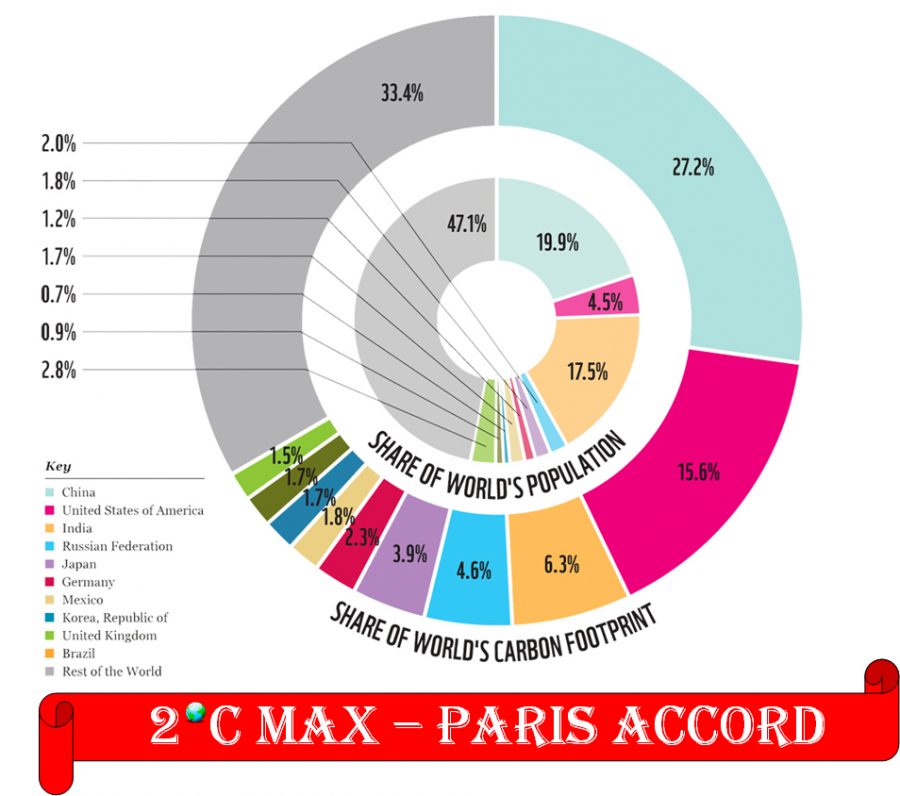Everyone’s carbon footprint counts
Not one nation, organization can bear responsibility of solving climate crisis
The effects of climate change can be seen in the Palouse, from the increase in maximum summer temperatures to the increase in annual number of days above freezing.
November 18, 2021
What do you know about the current impacts of climate change and the measures that are being taken to counteract its effects? If you know anything, it may be the political aspects of it.
You may have heard about Alexandria Ocasio-Cortez screaming at the top of her lungs in every press meeting about how we are not doing enough, or Greta Thunberg constantly challenging the world leaders that do not address this issue, or you might even have heard about former President Donald Trump leaving the Paris Climate Agreement.
But is that the right focus? Is addressing climate change just a political problem?
In December 2015, 192 nations (191 countries plus the European Union) came together and agreed to the terms of the Paris Climate Agreement, pledging to the goals set at the United Nations Climate Change Conference (COP21).
The major goals of the agreement include:
- Limiting the global temperature increase in this century to under 2 degrees Celsius
- Keep pursuing efforts to limit the increase even further to under 1.5 degrees Celsius
- Strengthen the resilience and enhance the abilities to adapt to the already existing and growing impacts of climate change
- Review countries’ commitments every 5 years
- Provide financing to developing countries to mitigate climate change, and much more
For the agreement to go into effect, at least 55 countries representing at least 55 percent of global emissions had to send their official confirmation called the “instrument of ratification.”
This happened at the COP21, and a legally-binding international treaty on climate change was signed and entered force on Nov. 4, 2016. The real work began after.
In 2020, every nation that signed the treaty was asked to submit their nationally determined contributions (NDC), which projects the actions they will take to reduce their greenhouse gas emissions in order to reach the goals of the Paris Climate Agreement.
They were also asked to submit long-term low greenhouse gas emission development strategies providing a vision and direction for future development. If you are interested, review what these nations submitted to the UN in 2020-21 about their NDCs.
All of these would be reviewed five years after the original signing of the treaty, which was Thursday Nov. 4, 2021.
So here comes the real question: How many of us even knew that there was an agreement and we were working toward it? How can each one of us contribute to meet this nation/global wide goals?
As you can see from the figure, the U.S. has the highest greenhouse gas emission per capita.
With the current political climate and the regulations of the Paris Climate Agreement, it was crucial for the U.S. to stay and support this global cause. Thanks to President Joe Biden, the U.S. has revamped the process and is now back on the climate agenda.
Finally, they could at least take one action after everything they promised during the presidential campaign for improving the global climate change impacts.
The COP26 climate conference held in Glasgow, Scotland, primarily focused on clean technology innovation and sustainable production.
Believe it or not, since the signing of the treaty, funding for key research programs at the Department of Energy went up by nearly $300 million every year — the first significant increase in almost four decades.
Since 2016, the U.S. has invested a lot in inventing zero-carbon alternatives. Now, we need to make sure they are affordable and accessible enough for people all over the world to use them.
This requires significant input from everyone in leadership roles that can make an effect: government officials, private sectors, philanthropists, researchers and the public.
How can we help?
“It is important to recognize that we all individually and as a university contribute to these impacts and hence can individually reduce our carbon footprint,” said Stevie Fawcett, director of WSU’s Environmental Sustainability Alliance.
Carbon footprint is the amount of carbon — usually in tonnes — emitted by an individual, an activity or an organization.
The Pullman City Council is working on addressing some of these impacts as well.
“We are expecting to have a group of members or even a department that will be dedicated to addressing some of the climate change impacts in the city of Pullman,” Pullman Planning Director RJ Lott said.
“The Citizens’ Climate Lobby, ESA, and the City Council have put together a climate change survey that all community members are encouraged to participate in,” Fawcett said.
As a first step, we could all participate in this survey to get a better understanding of some of the climate change impacts on the Palouse.
“The survey was primarily targeted at the Pullman community to share their opinions and help guide some of the climate action plans for the next few months,” Lott said.
ESA has also initiated a campaign calling on the university administration to fully divest its endowment funds from fossil fuel companies on the grounds of both financial and environmental responsibility.
“The ESA will send out a survey soon to all WSU students asking for their support in this campaign,” Fawcett said.
As a WSU student and as an individual that cares about our personal and nation-wide climate goals, I believe it is our responsibility to participate in shrinking our university’s carbon footprint and hold WSU accountable to divesting from current fossil fuel interests.
While all of these student organizations, non-academic entities and the City Council are working on revamping the climate action plan for the next few years, there are certain things we can do by ourselves.
You can learn about some of the carbon alternatives that are available to us — avoiding plastics, eating more plant based foods, composting your food wastes, recycling without contamination, purchasing reusable utensils, boycotting fast fashion and so much more.
“This could be the smallest change like switching to more efficient lamps at home, using greener fuels, switching to electric vehicles, using public transportation or investing in solar cells for your house,” Fawcett said.
To participate in WSU-wide sustainability efforts, please check out some of the greener alternatives at WSU online.
The continued efforts of the Paris Climate Agreement and WSU’s Climate Action Plan are examples of humans working together to save our planet from ourselves.
Lack of participation from every individual contributes to the additional impacts. There is no need to complain about the hierarchy of things we do not have control over. Let us focus more on what we can do as an individual to reduce our carbon footprint.

















